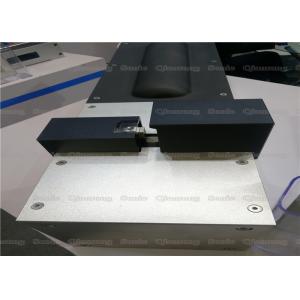

Add to Cart

Providing 20Khz Ultrasonic Splicing Metal Welding Solution for Tin and Oxidized Wire Harnesses
Description:
Ultrasonic automotive wire harness welding uses ultrasonic metal
welding technology to weld metal wire harnesses, and converts
high-frequency electrical energy into a mechanical vibration energy
through a transducer to act on the metal wire harness. When the
temperature of vibration friction heat reaches the melting point of
the wire metal, the wire harness It will melt, and the wire harness
will apply a certain pressure while the wire bundle is being fused.
Finally, the wire harness welding device moves away and stops the
mechanical vibration, which will form a wire harness welding
effect. During the wire harness welding process, no current is
passed through the weldment, and no welding arc is generated.
Because ultrasonic welding does not have problems such as heat
conduction and electrical resistivity, it is undoubtedly a kind of
welding for non-ferrous metal wire harnesses. In an ideal metal
wire harness welding system, the wire harness welding effect is
generally square.
Features:
1. High-quality welding head: Metal welding, as an industrial use, necessarily requires a high-life welding head.
2. High-quality control system: It has three basic control modes: welding energy, time and height. Various quality control softwares meet different needs.
3. Metal welding machines use high-quality transducers: such as 20kHz transducers, they must be able to withstand loads of more than 3kw for a long time. Many companies' transducers, which use ordinary plastic welded transducers, are difficult to distinguish in appearance, which is irresponsible.
Parameters:
| Item No | QR-X2020A | QR-X2030A | QR-X2040A |
| Power | 2000W | 3000W | 4000W |
| Welding Area | 0.5-16mm2 | 0.5-20mm2 | 1-30mm2 |
| Air Pressure | 0.05-0.9MPa | 0.05-0.9MPa | 0.05-0.9MPa |
| Frequency | 20KHZ | 20KHZ | 20KHZ |
| Voltage | 220V | 220V | 220V |
| Weight of horn | 18KG | 22KG | 28KG |
| Dimension of Horn | 530*210*230mm | 550*220*240mm | 550*250*240mm |
| Generator Size | 540*380*150mm | 540*380*150mm | 540*380*150mm |
What are the differences between ultrasonic metal welding machines and ultrasonic plastic welding machines?
1. The way of working is different. Generally, the vibration direction of the welding head in the ultrasonic plastic welding is perpendicular to the welding position, and the vibration direction of the welding head in the ultrasonic metal welding machine is parallel to the welding position. In some special cases, plastic welding can also be used in parallel directions, such as thin plastic parts.
High power capacity, stable ultrasonic generator:
The first requirement for a stable ultrasonic generator is: automatic frequency tracking. Automatic frequency tracking ensures that the transducer system can operate in a resonant state, ie the maximum amplitude of the weld head. The frequency is automatically tracked, the mold is replaced and the frequency is not required to work, which is the basic requirement for metal welding. Equipment with adjustable inductance and manual frequency adjustment can not meet the requirements.
2. Due to the application of metal welding machine to welding metal, higher requirements are put forward for ultrasonic welding technology. Compared with ordinary plastic welding, the requirements for power capacity, power density, stability and automation control are not the same. level. At present, domestic ultrasonic plastic welding generators basically adopt self-excited circuits, which are typically represented by full-bridge circuits and half-bridge circuits commonly used in Taiwanese machines. The remarkable feature is that there is a tuning inductor. If the existing mature technology for plastic welding is directly transferred to metal welding, its technical insufficiency will lead to unstable use of the product; its only advantage is that it is cheap, but for the high requirements of metal welding itself, This advantage is very pale.
Stable ultrasonic generators also require: constant amplitude function and stepless adjustment of amplitude. Constant amplitude function, which can ensure the consistency of welding, is the key to stable production; the stepless adjustment of amplitude is the basic to ensure the use of equipment, for example, it can weld copper and weld aluminum materials through parameter adjustment on the same equipment.
High power capacity: Compared with plastic welding machines, metal welding machines require high energy density, and must have relatively high power capacity. For example, a 20 kHz machine basically requires a power capacity of more than 3000 W. Many companies often have false nominals for power capacity, so we only need to compare them with the plastic welders they make, because the plastic welder is too high to be unbelievable.
Providing 20Khz Ultrasonic Splicing Metal Welding Solution for Tin and Oxidized Wire Harnesses
